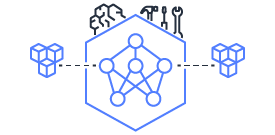This document is relevant for: Inf1, Inf2, Trn1, Trn2, Trn3
Using NEURON_RT_VISIBLE_CORES with TensorFlow Serving#
TensorFlow serving allows customers to scale-up inference workloads
across a network. TensorFlow Neuron Serving uses the same API as normal
TensorFlow Serving with two differences: (a) the saved model must be
compiled for Inferentia and (b) the entry point is a different binary
named tensorflow_model_server_neuron. Follow the steps below
to install the package using apt-get or yum. This will be pre-installed in a future relase.
Install TensorFlow Model Server and Serving API#
Follow the steps in the Install TensorFlow Neuron.
Then ensure you install using either apt-get or yum. If using TF 1.x, install the appropriate version (see above).:
sudo apt-get install tensorflow-model-server-neuron
or
sudo dnf install tensorflow-model-server-neuron
Also, you would need TensorFlow Serving API (use –no-deps to prevent installation of regular tensorflow). Depending on the version of Tensorflow you wish to use:
For Tensorflow 1.x:
pip install --no-deps tensorflow_serving_api==1.15
For Tensorflow 2.x:
pip install --no-deps tensorflow_serving_api
For the example image preprocessing using Keras preprocessing, the Python Imaging Library Pillow is required:
pip install pillow
To workaround h5py issue aws/aws-neuron-sdk#220:
pip install "h5py<3.0.0"
Export and Compile Saved Model#
The following example shows graph construction followed by the addition of Neuron compilation step before exporting to saved model.
For Tensorflow 1.x:
import tensorflow as tf
import tensorflow.neuron
tf.keras.backend.set_learning_phase(0)
tf.keras.backend.set_image_data_format('channels_last')
model = tf.keras.applications.ResNet50(weights='imagenet')
sess = tf.keras.backend.get_session()
inputs = {'input': model.inputs[0]}
outputs = {'output': model.outputs[0]}
# save the model using tf.saved_model.simple_save
modeldir = "./resnet50/1"
tf.saved_model.simple_save(sess, modeldir, inputs, outputs)
# compile the model for Inferentia
neuron_modeldir = "./resnet50_inf1/1"
tf.neuron.saved_model.compile(modeldir, neuron_modeldir, batch_size=1)
For Tensorflow 2.x:
import tensorflow as tf
import tensorflow.neuron as tfn
import numpy as np
tf.keras.backend.set_learning_phase(0)
tf.keras.backend.set_image_data_format('channels_last')
image_sizes = [224, 224]
model = tf.keras.applications.ResNet50(weights='imagenet')
example_inputs = tf.random.uniform([1, *image_sizes, 3], dtype=tf.float32)
# run the model once to define the forward pass and allow for saving
model_neuron(example_inputs)
model_neuron = tfn.trace(model, example_inputs)
tf.keras.models.save_model(model_neuron, './resnet50_inf1/1')
Serving Saved Model#
User can now serve the saved model with the tensorflow_model_server_neuron binary. To utilize multiple NeuronCores, it is recommended to launch multiple tensorflow model servers that listen to the same gRPC port:
export NEURON_RT_VISIBLE_CORES=0 # important to set this environment variable before launching model servers
tensorflow_model_server_neuron --model_name=resnet50_inf1 \
--model_base_path=$(pwd)/resnet50_inf1/ --port=8500
#then to run another server on a different neuron core open another
#window and run this, except this time set NEURON_RT_VISIBLE_CORES=1
#you can keep doing this up to the number of Neuron Cores on your machine
export NEURON_RT_VISIBLE_CORES=1
tensorflow_model_server_neuron --model_name=resnet50_inf1 \
--model_base_path=$(pwd)/resnet50_inf1/ --port=8500
The compiled model is staged in Inferentia DRAM by the server to prepare for inference.
Generate inference requests to the model server#
Now run inferences via GRPC as shown in the following sample client code:
For Tensorflow 1.x:
import numpy as np
import grpc
import tensorflow as tf
from tensorflow.keras.preprocessing import image
from tensorflow.keras.applications.resnet50 import preprocess_input
from tensorflow.keras.applications.resnet50 import decode_predictions
from tensorflow_serving.apis import predict_pb2
from tensorflow_serving.apis import prediction_service_pb2_grpc
if __name__ == '__main__':
channel = grpc.insecure_channel('localhost:8500')
stub = prediction_service_pb2_grpc.PredictionServiceStub(channel)
img_file = tf.keras.utils.get_file(
"./kitten_small.jpg",
"https://raw.githubusercontent.com/awslabs/mxnet-model-server/master/docs/images/kitten_small.jpg")
img = image.load_img(img_file, target_size=(224, 224))
img_array = preprocess_input(image.img_to_array(img)[None, ...])
request = predict_pb2.PredictRequest()
request.model_spec.name = 'resnet50_inf1'
request.inputs['input'].CopyFrom(
tf.contrib.util.make_tensor_proto(img_array, shape=img_array.shape))
result = stub.Predict(request)
prediction = tf.make_ndarray(result.outputs['output'])
print(decode_predictions(prediction))
For Tensorflow 2.x:
import numpy as np
import grpc
import tensorflow as tf
from tensorflow.keras.preprocessing import image
from tensorflow.keras.applications.resnet50 import preprocess_input
from tensorflow_serving.apis import predict_pb2
from tensorflow_serving.apis import prediction_service_pb2_grpc
from tensorflow.keras.applications.resnet50 import decode_predictions
tf.keras.backend.set_image_data_format('channels_last')
if __name__ == '__main__':
channel = grpc.insecure_channel('localhost:8500')
stub = prediction_service_pb2_grpc.PredictionServiceStub(channel)
img_file = tf.keras.utils.get_file(
"./kitten_small.jpg",
"https://raw.githubusercontent.com/awslabs/mxnet-model-server/master/docs/images/kitten_small.jpg")
img = image.load_img(img_file, target_size=(224, 224))
img_array = preprocess_input(image.img_to_array(img)[None, ...])
request = predict_pb2.PredictRequest()
request.model_spec.name = 'resnet50_inf1'
request.inputs['input_1'].CopyFrom(
tf.make_tensor_proto(img_array, shape=img_array.shape))
result = stub.Predict(request)
prediction = tf.make_ndarray(result.outputs['output_1'])
print(decode_predictions(prediction))
This document is relevant for: Inf1, Inf2, Trn1, Trn2, Trn3
